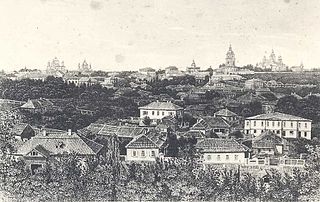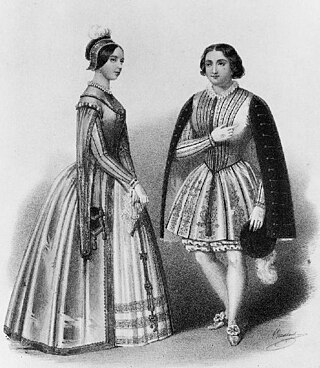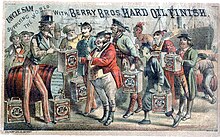
Lithography is a planographic method of printing originally based on the immiscibility of oil and water. The printing is from a stone or a metal plate with a smooth surface. It was invented in 1796 by the German author and actor Alois Senefelder and was initially used mostly for musical scores and maps. Lithography can be used to print text or images onto paper or other suitable material. A lithograph is something printed by lithography, but this term is only used for fine art prints and some other, mostly older, types of printed matter, not for those made by modern commercial lithography.

Halftone is the reprographic technique that simulates continuous-tone imagery through the use of dots, varying either in size or in spacing, thus generating a gradient-like effect. "Halftone" can also be used to refer specifically to the image that is produced by this process.

Woodcut is a relief printing technique in printmaking. An artist carves an image into the surface of a block of wood—typically with gouges—leaving the printing parts level with the surface while removing the non-printing parts. Areas that the artist cuts away carry no ink, while characters or images at surface level carry the ink to produce the print. The block is cut along the wood grain. The surface is covered with ink by rolling over the surface with an ink-covered roller (brayer), leaving ink upon the flat surface but not in the non-printing areas.

Offset printing is a common printing technique in which the inked image is transferred from a plate to a rubber blanket and then to the printing surface. When used in combination with the lithographic process, which is based on the repulsion of oil and water, the offset technique employs a flat (planographic) image carrier. Ink rollers transfer ink to the image areas of the image carrier, while a water roller applies a water-based film to the non-image areas.
Color printing or colour printing is the reproduction of an image or text in color.

Johann Alois Senefelder was a German actor and playwright who invented the printing technique of lithography in the 1790s.

Zincography was a planographic printing process that used zinc plates. Alois Senefelder first mentioned zinc's lithographic use as a substitute for Bavarian limestone in his 1801 English patent specifications. In 1834, Federico Lacelli patented a zincographic printing process, producing large maps called géoramas. In 1837–1842, Eugène-Florent Kaeppelin (1805-1865) perfected the process to create a large polychrome geologic map.
Michael Twyman is a Professor Emeritus of the Department of Typography & Graphic Communication at the University of Reading. He joined the university staff in 1959. He established a BA (Hons) course in Typography & Graphic Communication which eventually grew into its own department in 1974. Both the programme and the department are widely acknowledged to be the first of their kind in the world. He retired from full-time teaching in 1998 but still teaches postgraduate students and is also the Director of the Centre for Ephemera Studies.

The history of printing starts as early as 3000 BCE, when the proto-Elamite and Sumerian civilizations used cylinder seals to certify documents written in clay tablets. Other early forms include block seals, hammered coinage, pottery imprints, and cloth printing. Initially a method of printing patterns on cloth such as silk, woodblock printing for texts on paper originated in China by the 7th century during the Tang dynasty, leading to the spread of book production and woodblock printing in other parts of Asia such as Korea and Japan. The Chinese Buddhist Diamond Sutra, printed by woodblock on 11 May 868, is the earliest known printed book with a precise publishing date. Movable type was invented by Chinese artisan Bi Sheng in the 11th century during the Song dynasty, but it received limited use compared to woodblock printing. However, the use of copper movable types was documented in a Song-era book from 1193, and the earliest printed paper money using movable metal type to print the identifying codes were made in 1161. The technology also spread outside China, with the oldest extant printed book using metal movable type being the Jikji, printed in Korea in 1377 during the Goryeo era.

A. Hoen & Co. was a Baltimore, Maryland-based lithography firm founded by Edward Weber in the 1840s as E. Weber & Company. When August Hoen took it over following Weber's death, he changed the name and built the company into one of the most prominent in the industry at the time. In 1877, Hoen entered a print produced by his patented lithocaustic process in the Centennial Exposition. This work, entitled "The Continentals" was "commended for excellence in chromo-lithographic art" by the judges.
Mourlot Studios was a commercial print shop founded in 1852 by the Mourlot family and located in Paris, France. It was also known as Imprimerie Mourlot, Mourlot Freres and Atelier Mourlot. Founded by Francois Mourlot, it started off producing wallpaper. Later, his son Jules Mourlot would expand the business to handle the production of chocolate labels for companies such as Chocolat Poulain, as well as ledgers, maps and stationery. Starting in the 1920s, Jules' son, Fernand Mourlot, converted one of the locations into a studio dedicated to printing fine art lithography.

George Baxter (1804–1867) was an English artist and printer based in London. He is credited with the invention of commercially viable colour printing.
Vincent Brooks, Day & Son was a major British lithographic firm most widely known for reproducing the weekly caricatures published in Vanity Fair magazine. The company was formed in 1867 when Vincent Brooks bought the name, good will and some of the property of Day & Son Ltd, which had gone into liquidation that year. The firm reproduced artwork and illustrations and went on to print many of the iconic London Underground posters of the twenties and thirties before being wound up in 1940.

Kurz and Allison were a major publisher of chromolithographs in the late 19th century. Based at 267-269 Wabash Avenue in Chicago, they built their reputation on large prints published in the mid-1880s depicting battles of the American Civil War. In all, a set of 36 battle scenes were published from designs by Louis Kurz (1835–1921), himself a veteran of the war. Kurz, a native of Salzburg, Austria, had emigrated to the United States in 1848.

M. & N. Hanhart was a London lithographic publishing house founded by Michael Hanhart and Nicholas Hanhart (1815–1902).

The illustration of manuscript books was well established in ancient times, and the tradition of the illuminated manuscript thrived in the West until the invention of printing. Other parts of the world had comparable traditions, such as the Persian miniature. Modern book illustration comes from the 15th-century woodcut illustrations that were fairly rapidly included in early printed books, and later block books. Other techniques such as engraving, etching, lithography and various kinds of colour printing were to expand the possibilities and were exploited by such masters as Daumier, Doré or Gavarni.

Chromoxylography was a colour woodblock printing process, popular from the mid-19th to the early-20th century, commonly used to produce illustrations in children's books, serial pulp magazines, and cover art for yellow-back and penny dreadfuls. The art of relief engraving and chromoxylography was perfected by engravers and printers in the 19th century, most notably in Victorian London by engraver and printer Edmund Evans who was particularly good with the process, producing a wide range of hues and tones through color mixing. Chromoxylography was a complicated technique, requiring intricate engraving and printing for the best results. Less expensive products, such as covers for pulp magazines, had to be produced with few colours, often only two or three, whereas more intricate and expensive books and reproductions of paintings used as many as a dozen or more colors. For each colour used, a separate woodblock had to be carved of the image being reproduced.

John Brandard was an English lithographic artist. He designed many hundred illustrated title-pages for sheet music in what Michael Bryan judged "a pretty, though weak, style".
William Griggs was an English inventor of a process of chromolithography known as photo-chromo-lithography. He was associated with the India Office, and publications for which he produced coloured illustrations include many works about India.

Hermann Joseph Mitterer, was a German drawing teacher, founder of Munich's Feiertägliche Zeichnungsschule in 1792 and co-founder of Feiertagsschule München in 1793, forerunners of later vocational schools. On Mitterer's initiative, drawing lessons were made compulsory in all schools in Bavaria as early as 1789. He also founded the first Lithographische Kunstanstalt.



















